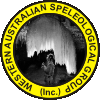 |
Some call them crazy, some call them intrepid, we simply call them the cavers on the pre-UIS Conference trip to Magaret River.
Thanks to Tim for the preconference images at Margaret River and Marcos for some at the conference.
 |
Project images are HERE |
In 2006, there was a break-in at Crystal Cave (the show cave in Yanchep National Park) and a number of the speleothems were broken or removed. Norm Poulter of SRGWA carefully mapped where the various broken parts were found before they were gathered up.
Acting on information received, the police retrieved the stolen stals and charged the culprit. Two years or more of legal wrangling followed, in the course of which the caving clubs were asked to place a monetary value on the damaged formations. Despite the impossible nature of this request, we did our best to provide appropriate information.
Eventually, the vandal received a 200-hour community work order – a disappointing result from a caver’s perspective.
Only then were the cavers free to attempt some rectification of the damage. Norm Poulter organised the first part of the job, and Ian Collette of WASG took over the work when Norm moved to Tasmania.
 |
Expedition images are HERE |
In 2016, a grant made available to Dr W.F. (Bill) Humphreys of the W.A. Museum allowed him to organise an expedition to Cape Range to expand an already long running project looking at the genetic data of the cave invertebrates.
Up until 2016 the small amount of funds available only allowed him to focus on one main group, the blind millipedes of the genus Stygiochiropus. These millipedes have revealed an interesting distribution of genes into provinces whereby populations are isolated or semi-isolated from each other by natural barriers such as gorges. On this trip the aim was to collect specimens from other families of troglobites (animals obliged to dwell within the cave environment) such as Schizomida (micro-whip scorpions), pseudoscorpions (not particularly closely related to real scorpions, although they bear a distinct similarity), cave spiders, isopods (commonly known as woodlice) and etc. The trip was very successful with many specimens collected from a variety of caves ranging from shallow pits a few metres deep to caves over 50 m deep and many hundreds of metres in horizontal extent. It may take several years for the data from the specimens to be processed and to reveal its many secrets, such as degree and time of divergence from other populations, and in fact whether the divergence actually mimics that of the millipedes.
The participants were Dr Humphreys, his assistant Julianne Waldock, both from the W.A. Museum and WASG members Luana Dwyer, Fran Head, Ian Collette, Brett Wiltshire and Darren Brooks.
Darren made the following video of the expedition - well worth viewing ...
 |
Trip images are HERE |
The 2016 WASG Kimberley expedition took place in July when the intrepid participants, Brett Wiltshire, Danny Wilkinson, Andrew Thomas and Bert De Waele, all from Perth, and Barry Cullen and Darren Brooks, both from Exmouth and, from Mole Creek Caving Club in Tasmania, Jessica Bertels, headed north to discover and explore as many caves as they possibly could in the two weeks of the trip. Not to be left out, a trip was made to the iconic Tunnel Creek where the crew enjoyed the delights of KO-1, The Tunnel. The team mapped eleven smallish caves during the trip and explored a great deal of the area hoping to find a large cave system. As is usual with these trips the best find was on the second last day when we discovered a nice shaft of 20 m depth but without time to explore it. The final day was taken up with last minute surveying by a couple of teams and the remainder decided to explore the large and pretty Ballgown/Firemans Pole system
Danny Wilkinson created the video below on the trip back. It shows some of the beauty and ruggedness (also good piloting/photographic skills)















